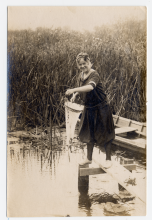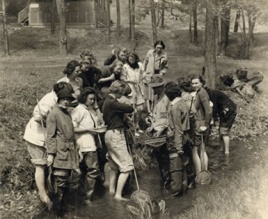Ann Haven Morgan
- Ann had several endearing nicknames due to her study of different insects and fish, including “Mayfly Morgan,” “Big Fish Lady” and “Water Bug Lady”?
- Ann hoped her published work, Field Book of Ponds and Streams, would “help toward wider enjoyment and further acquaintance in the field of water biology that offers abundant opportunity to all explorers, both beginners and seasoned investigators”?
- Friends and students described Ann in various interesting ways, including: one who was always on her own; a “complex” woman who was “consistently kind, helpful, cordial;” a woman diminutive in stature but exacting, with “bobbed hair and blue eyes who always wore a tailored skirt, shirtwaist, tie, and white physician’s coat”?
- Ann once told a reporter in 1945 that she did not “ever want to come out’ of some particularly oozy mudhole, where she happily captures nymphs, sponges and other creature and encourages her students to do the same“?
- Ann was bestowed with many honors, from being a Schuyler Fellow at Cornell, a visiting fellow at Harvard and Yale, a fellow in the American Association for the Advancement of Science, a member of the Entomological Society of America, the American Society of Naturalists, the American Society of Zoologists, and many others?
- 1882 Ann Haven Morgan is born.
- 1906 She receives her A.B. from Cornell; becomes assistant and then full instructor in zoology at Mount Holyoke.
- 1912 She receives her doctorate from Cornell with her dissertation on the biology of Mayflies.
- 1916 Becomes chairman of the zoology department at Mount Holyoke.
- 1918-1923 Teaches marine zoology at Woods Hole Marine Biological Laboratory in Massachusetts.
- 1926 Researches at the tropical Laboratory in Kartabo, British Guiana.
- 1930 Publishes A Field Book of Ponds and Streams based on her Kartabo research.
- 1947 She retires from teaching at Mount Holyoke and joins the National Committee on Policies in Conservation Education; she travels to the western U.S. to observe conservation efforts and believes their efforts are more advanced than those in the east.
- 1955 She publishes Kinships of Animals and Man—A Textbook of Animal Biology.
- 1966 Ann passes away from cancer.
Ann Haven Morgan (1882-1966) loved to study ponds and streams (limnology), observing the insect and plant life there. In 1902 she enrolled at Wellesley College but found it rigid and transferred to Cornell (she received her A.B. in 1906). After graduating from Cornell, she became an assistant and then full instructor in zoology at Mount Holyoke College in Massachusetts. She eventually became chairman of the zoology department and gave courses on water biology (with field trips) and winter biology. In 1910 she became James G. Needham’s doctoral student at Cornell and published a doctoral thesis on the biology of Mayflies.
Between 1918 and 1923, Ann taught about echinoderms at the Woods Hole Marine Biological Laboratory in Massachusetts. Three years after this, she did research in the Tropical Laboratory in Kartabo, British Guiana; this research became the basis for her book, A Field Book of Ponds and Streams (published in 1930). Her book was instantly successful, and contained her original illustrations and photographs. In 1933, Ann was one of three women featured in a group of 250 leading scientists of the time in the journal, American Men of Science. Ann tried to establish conservation and ecology as mainstays of study in science classes; she lived to see the growth of the ecological movement.




